In addition to representing a work's various states of restoration, the images in many cases document destroyed or lost objects and structures. Notable examples include Raphael's Portrait of a Young Man, formerly in the Czartoryski collection but lost during World War II, and an important group of photographs by Lucienne Bloch documenting Diego Rivera's destroyed Rockefeller Center mural of 1933. Images of many destroyed buildings are also preserved in the collection, including Lowther Castle (Cumbria, England), Eaton Hall (Cheshire, England), the Königliches Schloss (Berlin), and the library at the Soldiers' Home in Washington, DC.
Research in the Collection
The size and broad scope of the department of image collections enables researchers to pursue a wide range of art-historical concerns, such as connoisseurship, provenance, and conservation. Images from the collection's varied sources can provide a visual history of a particular work of art. This includes photographs taken of an object while in different collections or states of conservation. For example, one of the oldest photographs in the collection, an image from 1857 of Raphael's Small Cowper Madonna (National Gallery of Art, Widener Collection) documents the work as part of the Cowper collection in Panshanger, England, and shows the composition obscured by dirt, heavy overpaint, and varnish. Later images depict the painting after subsequent restorations, until finally the details of the background and the parapet behind the Madonna are exposed.
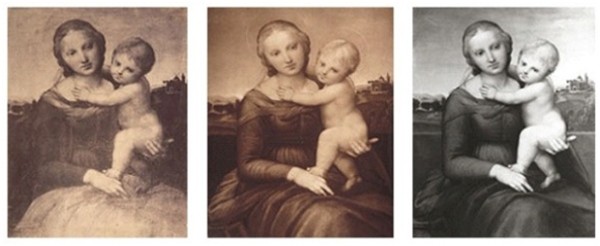
Left: Raphael, Small Cowper Madonna, c. 1505, before restoration (note discoloration across the Madonna's lap and the dark landscape); matte albumen print from Photographs of the "Gems of the Art Treasures Exhibition," Manchester, 1857, published jointly by Thomas Agnew and P. and D. Colnaghi, photograph Caldesi and Montecchi. Center: Raphael, Small Cowper Madonna, c. 1505, after minor restorations, background slightly less obscured; carbon print, c. 1910, photograph Adolphe Braun et Cie. Right: Raphael, Small Cowper Madonna, c. 1505, after modern restoration (note parapet behind Madonna and details in landscape not previously apparent); silver gelatin print, c. 1986, photograph National Gallery of Art
Other examples of works in different states of restoration include images of Cellino Cellini's Perseus in the Galleria degli Uffizi, Florence, and views of the Laocoön, Museo Pio Clementino, Vatican, with and without its restored arms.
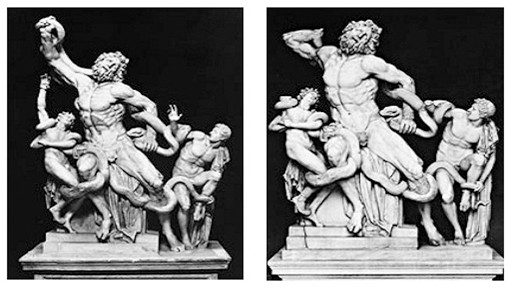
Left: Laocoön, early first century, with restored arms, Museo Pio Clementino, Vatican; silver gelatin print, photograph Brogi. Right: Laocoön, early first century, restoration removed, Museo Pio Clementino, Vatican; silver gelatin print, photograph Hirmer Verlag
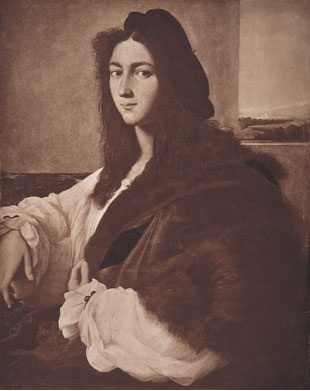
Raphael, Portrait of a Young Man, c. 1516, formerly Czartoryski collection, Krakow, lost during World War II; carbon print c. 1910, photograph Adolphe Braun et Cie
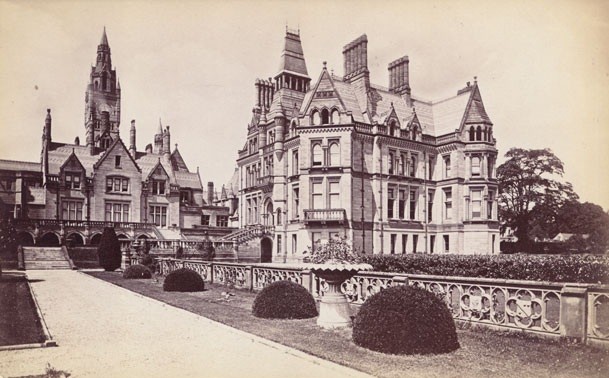
Eaton Hall, Cheshire, Alfred Waterhouse, architect, 1870-1883, demolished 1961; albumen print, photograph Gramstorff Collection
Another aspect of the collection is the documentation of a plethora of versions of old master paintings that have come to the image collectinos through scholars and dealers. The many versions of Satyr and a Maiden by Peter Paul Rubens (?) in the Gemäldegalerie Alte Meister, Dresden, provide an instructive and amusing example.
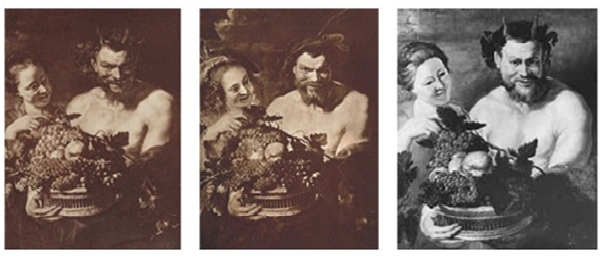
Left: Peter Paul Rubens (?), Satyr and a Maiden, c. 1612, probably original version (or direct copy after), Gemäldegalerie Alte Meister, Dresden; collotype, photograph F. Bruckmann A.G., Munich. Center: Copy after Peter Paul Rubens (?), Satyr and a Maiden, after c. 1612 (note changes in maiden's hair and costume, the Satyr's facial expression, and the addition of hats), Mauritshuis, The Hague; collotype. Right: Copy after Peter Paul Rubens (?), Satyr and a Maiden, twentieth century, modern interpretation, location unknown; silver gelatin print
Adding to the value of the photographs themselves, the majority of the prints in the collection are annotated on the back by a previous owner, be it a scholar, dealer, or museum. This historical context is important for provenance research and the history of connoisseurship as documentation of solicited scholarly opinions of works of art. An expert often wrote an opinion on the back of a photograph, which the dealer then showed to a prospective buyer. This practice, common in the early twentieth century, frequently resulted in the sale of a work of art because of its attribution to a known master. Many examples of these annotations, particularly for objects that were offered to Samuel Kress, are housed in image collections.
The library is open Monday through Friday 11:00 a.m. to 4:30 p.m. We are closed Saturday, Sunday, and federal holidays.
To help us prepare materials ahead of your initial visit, we recommend you request an appointment.
Location
National Gallery of Art East Building
4th Street and Pennsylvania Avenue NW
Washington, DC
Mailing Address
Image Collections
National Gallery of Art
2000 South Club Drive
Landover, MD 20785
Contact [email protected] or call (202) 842-6026
Travels Across Russia: Oranienbaum
In Situ: Henry Moore, David Finn, and the Experience of Location
Verrocchio, Connoisseurship, and the Photographs of Clarence Kennedy
Before the Fire: Notre-Dame de Paris in Pictures
Travels Across Russia: Avant-Garde Architecture in Moscow
John Brampton Philpot and Photography in 19th-Century Florence
Beauty, Fire, & Memory: Lost Art of the Kaiser-Friedrich-Museum
Process and Participation in the Work of Christo and Jeanne-Claude
Revelations from Reproductions:
Fifteenth-century Italian Paintings in the National Gallery of Art
The Solemnity of Shadows: Juan Laurent’s Vision of Spain
Patrimony in Peril: Germany’s Survey of Mural Paintings Threatened During World War II
War Damage in Baden and Württemberg: Monuments Men Albums
Travels across Russia: Ekaterinburg
Travels Across Russia: Torzhok
United States Centennial International Exhibition
Philadelphia - 1876